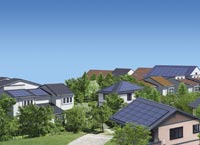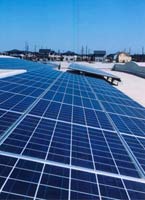|
|
|||||||
|
|
|||||||
|
|||||||
| | Web Japan >> | Trends in Japan >> | Business & Economy >> | Harnessing the Rising Sun | |
|
HARNESSING THE RISING SUN Household Solar Power Gains Momentum (October 6, 2006) In a time of high oil prices and growing concern over environmental problems, the number of Japanese homes equipped with solar power systems is on the rise. In addition to improvements in solar panel design and electrical output, the benefits of household solar power include the potential for recouping the installation costs by selling excess power back to the electricity company. Solar power is thus attracting the attention of consumers with a strong interest in energy conservation. 100,000 Solar-Powered Homes More and more such systems are being installed throughout Japan. According to the Yano Research Institute, the number of solar power systems installed in newly built or remodeled homes in fiscal 2005 (April 2005 to March 2006) stood at 69,500, an increase of 18.6% from the year before. This figure is projected to grow even further in fiscal 2006, likely exceeding 100,000 homes for the first time ever. In fact, the world's largest solar panel manufacturer, Sharp Corporation, forecasts that the market for solar power will continue to grow amid soaring fuel costs. Sekisui Chemical Co., Ltd. reported that 53% of the 11,500 Sekisui Heim houses it manufactured and sold in fiscal 2005 were equipped with solar power systems. Energy Self-sufficiency Japan led the world in total solar power output in 2005 at 1.13 million kilowatts. Meanwhile, the government has made lowering current power costs a priority and has a set a goal of equipping the country with a total solar power output of 4.82 million kilowatts by fiscal 2010. The growing importance of solar power as a means of combating global warming and reducing reliance on expensive oil imports suggests that this technology has a bright future. Copyright (c) 2006 Web Japan. Edited by Japan Echo Inc. based on domestic Japanese news sources. Articles presented here are offered for reference purposes and do not necessarily represent the policy or views of the Japanese Government. |
A LEGACY OF SUSTAINABILITY (November 25, 2005) |
|
|




